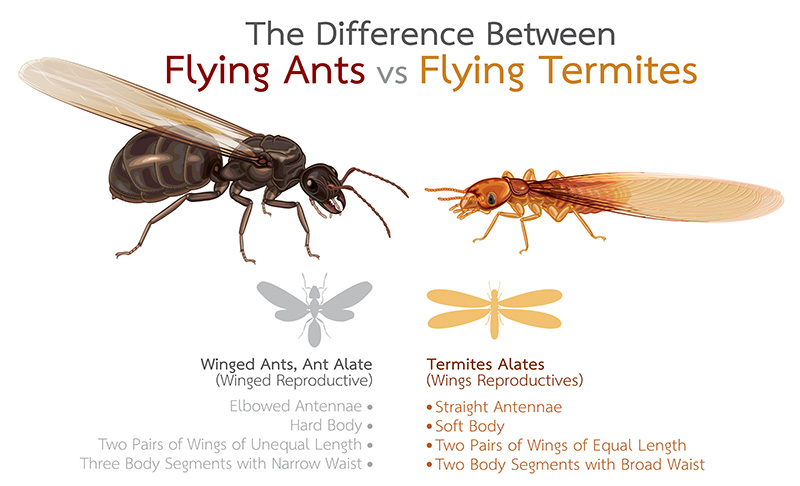What Are Flying Termite Alates?
In a termite colony, adult termites are divided into three castes: workers, soldiers, and reproductives.
Flying termites, also called alates, are the reproductive members. Their main role is to leave the original colony during a nuptial flight to start new colonies. This flight is often triggered by warm temperatures, high humidity, or recent rainfall.
When flying termites appear, it usually means termite mating season is underway—commonly occurring twice a year. During this time, thousands of winged termites take flight at the same time in a synchronised swarm, increasing their chances of finding a mate and a suitable nesting location.
How to recognise termite alates:
- Two pairs of equal-length wings
- Straight, bead-like antennae
- Dark brown or black body
- Broad waist (not pinched like ants)
Flying Termites vs Flying Ants – Key Differences
Flying ants (ant alates) can look similar to termite alates, which often causes confusion. However, there are clear differences:
| Feature | Termite Alates | Ant Alates |
|---|---|---|
| Wings | Two pairs of equal length | Front wings longer than hind wings |
| Waist Shape | Straight body | Pinched waist |
| Antennae | Straight, bead-like | Elbowed |
| Colour | Usually dark brown/black | Varies (brown, black, reddish) |
| After Mating | Shed wings | Keep wings |

Differences between Ant Alates and Termite Alates
Tip: If you see flying insects are aren’t sure, take a clear photo and send it to your pest control provider – they can identify them quickly.
What to Do If You See Flying Termites
Flying termites are not dangerous to humans directly, but they are a strong warning sign that termites are active nearby and looking to establish a new colony.
Here’s what happens after a termite flight:
- A male and female termite mate and shed their wings, and become king and queen.
- They seek a suitable nesting location with food (wood, cellulose) and moisture.
- If conditions are right, they start a new colony.
Important:
- The flight itself is brief—often over within an hour.
- You cannot “stop” the flight, but you can protect your property.
- The best action is to arrange a professional termite inspection to check for nearby activity.
Get a Free Termite Assessment
A Free Termite Assessment includes a visit from one of our qualified technicians at your property to look for visible signs of termite activity, discuss your concerns and your property’s termite history, and provide you with some options as to what to do next to enable you to make an informed decision about how to protect your property from termite attack.
Following your Assessment, you can book in a termite treatment OR send our technician on their way until you’re ready to book in, but you will be armed with all of the information for when you’re ready to make a booking. You’ve got nothing to lose and don’t worry, we won’t pressure you after we’ve been.
* Please note A Free Termite Assessment is NOT a full inspection.
You have nothing to lose because it is free, and you will have peace of mind knowing that the termite alates that you have seen haven’t set up a colony on your property.
You can book online by clicking the Book a Time Now button on the top right of this page or you can give us a call on 1300 65 65 72. Depending on whether we have a technician in your area, we can be at your place within one business day.
Suburban Pest Management are Experts in Termite Prevention
At Suburban, we specialise in termite detection and prevention. Our experienced team of experts is equipped with the knowledge and tools to assess your property’s risk, detect any existing infestations, and provide effective solutions tailored to your specific needs.
Understanding the risks termites pose is crucial for property owners. By implementing termite protection and seeking professional assistance when necessary, you can protect your property from the destructive effects of termites.
So to experience the Suburban difference, book a Free Termite Assessment online or give us a call on 1300 65 65 72 today.
Frequently Asked Flying Termite Questions
If you have any questions about Alates, we have provided answers to some frequently asked questions below:
No. While both termites and ants can have wings, flying termites (termite alates) have straight bodies, equal-sized wings, and straight bead-like antennae, while ant alates have pinched waists, unequal wings, and elbowed antennae.
The flying termites themselves do not cause structural damage, but their presence indicates a nearby termite colony that could infest and damage your property.
Flying termites usually appear twice per year during warm, humid conditions, often triggered by rainfall. This period marks the termite mating season.
If you see flying termites, arrange a professional termite assessment as soon as possible to check for nearby colonies and prevent potential infestations.


